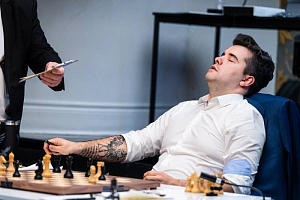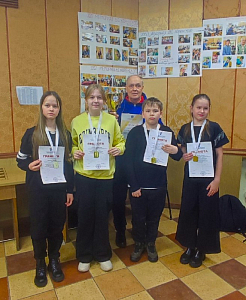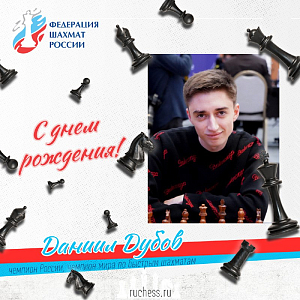To Dunyasha’’s Piping
Dmitry Kryakvin reports about rounds 6-7 of the Russian Superfinals in Satka
Rounds 6-7 of the main tournament of the Russian chess calendar were preceded by a rest day, so much looked forward to by all players. A rest day saw simuls given by the tournament commentator Alexander Morozevich (a famous grandmaster comments on the tournament developments in English), head coach of the women's national team Sergei Rublevsky, Pavel Tregubov, who has come to aid his wife Alexandra Kosteniuk; one of the heroes of the first half of the tournament Kobalia, and the author of these lines.
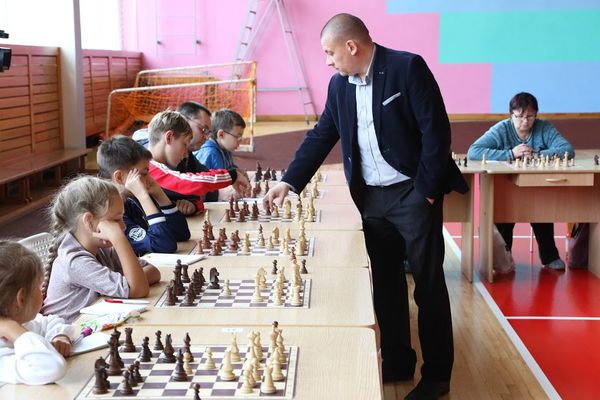
As you might already know from Eteri Kublashvili’s report, simul-givers won big-time - 90:2. Suffering greatest was me (a draw and a loss) - the Chelyabinsk coaching department legend, Pavel Ponkratov's coach Alexander Shchetinin, pitted his beloved pupils against the poor correspondent. The second draw was gifted to young players by Kobalia.
Alexander Shchetinin pupils’ level is best demonstrated by the following diagram. The game was the last in the simul and took a long time to finish - the arbiters refused to award it, experiencing difficulties in evaluation. However, as it often happens, left tete-a-tete with the simul-giver, a young chess player got excited and eventually blundered fatally.
Kryakvin – Belov

Then the simul-givers joined the tournament participants for a trip to Lake Zyuratkul’ and a tour of the conservation park. As we traveled, a guide was giving a very interesting narrative of Satka’s history. Of particular interest was the story about the Peasants' War of 1773-1775, when its leader, Yemelyan Pugachev, defeated by government forces, fell back to the city. The rebels were after a local treasury, which could not be found though.
This is when Yemelyan was approached by a 15-year-old girl, Dunyasha Nevzorova, to tell him who was hiding what and where. Out of sheer joy Yemelyan ordered that local harborers be hanged, with Dunyasha adding oil to the fire by supplying Pugachev with a list of town’s "bad people." Bad people followed suit of local harborers, whereas Nevzorova took off with Pugachev. Nevertheless, the most amazing happened afterwards: before arrested, Yemelyan Pugachev gifted a belt with gold inside to the "Satka’s Princess", who returned home, got married, gave birth to 14 children and lived to see 80 years. She was never harmed either by authorities or by her countrymen. Now they say that only good people live in Satka ever since.
Mikhail Kobalia's reaction to the story was the most emotional. 15 years is the age of the Russian Olympic junior team members. It is true that senior coach is blessed with the women team's lineup: Sasha Goryachkina, Dina Dordzhieva and Sasha Obolentseva. All of them are wonderful girls, no Dunyashas among them.
All in all, local legends have some solemn aura about them. It is about someone turning into stone or kidnapped by the bear. This is the nature of the Chelyabinsk region players, as if of stone. Suffice it to recall Karpov, not to mention Sveshnikov, Ponkratov... I imagine a bear coming for Evgeny Sveshnikov, and the latter welcoming him with: "Excuse me, are you familiar with my lecture on the Chelyabinsk variation?” A poor animal would surely drop dead there and then!

All pictures in the report are credited by Eteri Kublashvili
Rounds 6 and 7 were surprisingly rich in blood - a battle of nerves taking its toll. One of the participants said, "Gathered here are not only the adversaries of draws, but Dunyasha Nevzorova herself would have been happy!” However, first clashes took place before getting to know the legendary person.
Kobalia – Sarana
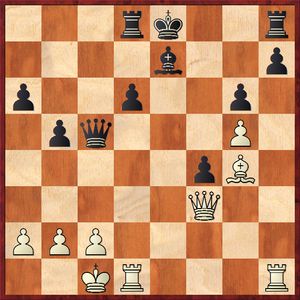
As opposed to that, Mikhail Kobalia was evaluating this position as critical, believing that something is bound to turn up for him. However, once he committed the wrong rook to e1, he immediately spotted the Qc3 idea, in which he would have actually profited from the rook on h1.
Indeed, after 26.Rde1! Qxg5 27.Qc3! White wins nicely in all lines: 27…f3+ 28.Kb1 Rf8 (28...Qxg4 29.Qf6 Kd7 30.Rxe7+ Kc8 31.Qc3+ Qc4 32.Qxf3 d5 33.Qf6 b4 34.Qe6+ Kb8 35.Qb6+ with a checkmate, 28...0–0 29.Be6+ Rf7 30.Bxf7+ Kxf7 31.Rxh7+ Ke8 32.Qc7 Rd7 33.Qc8+ Rd8 34.Qe6 again with a checkmate) 29.Rxh7 Rf7 30.Rh8+ Rf8 31.Rxf8+ Kxf8 32.Qh8+ Kf7 33.Be6#.
Jakovenko – Nepomniachtchi

At the press conference the winner shared about anticipating 19...Be6 here, and while Ian was deliberating on his next move, spotted that 20.c4 dxc4 21.Nxe6 Rxe6 22.Rac1 runs into an unpleasant rejoinder 22…Nd2!, and Black escapes in one piece. However, Ian opted for
19... Qd7?!, which afforded White the battering-ram idea of е5-е6.
20.Rad1 Nxc3 21.Rd3 Ne4
Dmitry proposed to go to all out with 21...Nxa4, which gives White a choice between 22.Bxd5 with a full compensation, and a more ambitious 22.e6 fxe6 23.Nxe6 Rxe6 24.Rxd5 Qe8 25.f5 or 25.Red1 Bf6 26. f5, which Jakovenko could not fully calculate. Meanwhile, the clocktime was melting down.
22.e6 fxe6?
This is a decisive mistake. The engine is again well done with 22...Qe7!? 23.Bxd5 f5, claiming that nothing is clear yet.
23.Nxe6 Nf6
More stubborn, perhaps, is 23...Rxe6 24.Rxd5 Qe8, which, nonetheless, gives White a pleasant choice between 25.Rd3 and 25.f5. Nepomniachtchi essayed to retain his plunder, but his royal fortress is windy beyond lending itself to defending.
24.f5! gxf5 25.Nxg7 Qxg7 26.Qf1! Be6 27.Bd4 Kf7
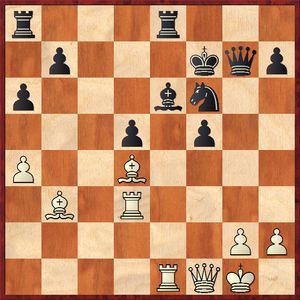
Here White has many tempting tactical resources, but Dmitry Jakovenko opted for a simple approach of ganging up on opponent’s weak points with all his might. I remember an acquaintance of mine saying, “Jakovenko’s games have magic of their own! He has everything put together in such a way that chess seems to be the simplest of games!“
28.Qf4 Bd7 29.Rf1 Be6 30.Rg3 Qh8 31.Qh4 Rad8 32.Bc2 h6 33.Bxf5 Black resigns.
Worthy of noting is a moment happened at a press conference given by a winner Evgeny Tomashevsky and a loser Daniel Dubov. Looking for counterplay in a worse position, Dubov ditched an exchange. The decision proved interesting from a practical point of view - Tomashevsky had to calculate lines, but White’s winning path was not a narrow one, and one of the most technical grandmasters of our times ended up converting his edge.
Tomashevsky - Dubov

A reasonable question arose at the pressroom - why not move the rook away from en prise? The grandmasters were skeptical, but Sergey Shipov took up the side of Black. Thus, after 23...Rc7 Evgeny Tomashevsky voiced for 24.Rb7 Rxb7 25.Bxb7, but after 24... Rb8 there is no 26.Bxc5? in view of 26…Nd7, and after 26.a6 Nd7 the с5-pawn is alive yet. Daniil Dubov thought 24.Bb7 to be stronger, but the analysis discovered 24…Re8 25.a6 and now even 25…h6 will do. One does not feel like defending a position like this at all. Despite this, the engine claims otherwise, and his opinion is hard to argue with. Anyway, Daniil has let his sole lead go because of this game.
Fedoseev – Inarkiev
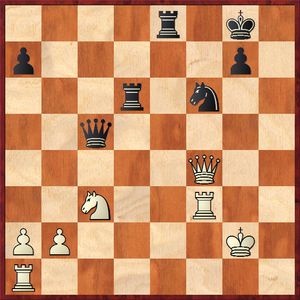
White’s position is exposed, but after 39.Rd1 there is nothing terribly wrong visible yet; however, after
39.b4? Qc6 40.Rc1 Rd3 41.b5 Rxf3 42.Qxf3 Qc5 the trade of rooks proved well timed for Black. The check from g5 is a threat, and the c3-knight is hanging.
43.Qf4 Re3 44.Qb8+ Kf7 45.Qb7+ Re7 46.Nd5
46.Qf3 fails to 46...Qg5+.
46...Qxd5+ 47.Qxd5+ Nxd5, and Black converted his up a piece edge.
Performance in the men's section did not plummet after the rest day - three draws and three decisive games. Peace was signed between Nikita Vitiugov with Evgeny Tomashevsky, while escaping from a tough position against Daniel Dubov was Vladimir Fedoseev. By the way, Daniil has come up with a very interesting idea against the opponent's trademark line a7-a6 in the Queen’s Gambit. Meanwhile, in the adjacent women’s section the same line for Black is regularly used by Valentina Gunina.
Dubov – Fedoseev
1.d4 d5 2.c4 e6 3.Nc3 a6 4.cxd5 exd5 5.Qb3 Nf6 6.Bg5 c6 7.e4!? (Quite recently Duda has employed a modest 7.e3 vs Fedoseev) 7...dxe4 8.Bc4 Qe7 9.a4 h6 10.Bxf6 gxf6 11.Nge2 with a powerful compensation for the pawn.
At last, Inarkiev – Andreikin was a third draw. Ernesto’s handling of the opening position was not to the point, and Andreikin was thought to show up at the press conference room before long. However, there was a sudden turn of the tables.
Inarkiev – Andreikin
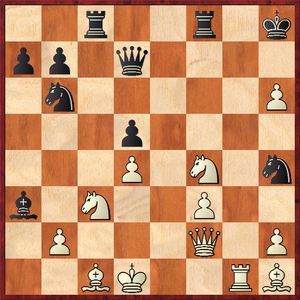
28... Rxc3! 29.bxc3 Qa4+ 30.Kd2
After 30.Qc2 Qxc2+ 31.Kxc2 Bxc1 White is down a piece, but now his centralized king should have spelt his doom.
30...Rxf4?
30...Nc4+ 31.Kd3 (31.Ke1 Re8+) 31...Bxc1 would have been an easier solution, whereas the text gives White a nice trick 31.Rg8+ Kh7 (taking the white rook drops its black counterpart on f4) 32.Rg7+ Kxh6 33.Qg3 Rxd4+ 34.cxd4 Qxd4+ 35.Kc2+ Bxc1 36.Kxc1 Qxg7 37.Qxh4+, with decent chances for a draw.
31.Qg3? Rxd4+ 32.cxd4
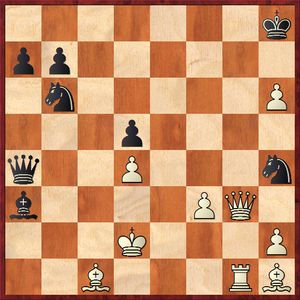
32...Nc4+?
Black is easily winning after 32...Bb4+ 33.Kd3 (33.Ke3 Nf5+) 33...Qb3+ 34.Ke2 Qc2+ 35.Kf1 Qxc1+ 36.Ke2 Qc2+ 37.Kf1 Qd1+ 38.Kf2 Qxd4+ 39.Ke2 Qd2+ 40.Kf1 Qd1+ 41.Kf2 Bc5#, but the heat of fight plays a cruel joke on the grandmaster from Ryazan.
33.Ke2 Qc2+ 34.Kf1 Qd3+ 35.Kf2 Qc2+ 36.Kf1 Qxc1+ 37.Qe1 Qxe1+?!
37...Qxh6 38.Qg3 (38.Qe8+ Bf8) 38...Qc1+ 39.Qe1 Nf5 leaves Black chances for victory, while now White’s forces come to life, his dead h1-bishop assisted by rook saving Inarkiev's army from defeat.
38.Kxe1 Nf5 39.f4 Nce3 40.Ke2 Bd6 41.Rg7! Bxf4 42.Rxb7 Nxd4+ 43.Kf2 a5 44.Rd7 Ng4+ 45.Kf1 Ne3+ 46.Kf2 Ng4+ 47.Kf1 Nxh2+ 48.Ke1 Nhf3+ 49.Kf2 Ne5 50.Rxd5 with a draw.
May it be that the rest day was to the detriment of certain players, putting them off their strides? In yet another game the losing side was seen taking a fatal step into the abyss himself.
Sarana – Jakovenko
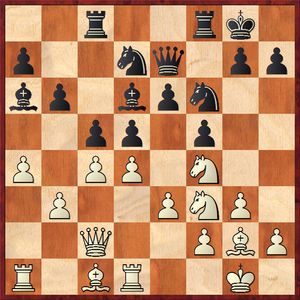
Jakovenko was anticipating 18.Ng5! Bxf4 19.exf4 with an edge for White and could not believe his eyes when seeing the opponent’s move!
18.cxd5? cxd4 19.Qb2 dxe3 20.Nxe6 exf2+ 21.Qxf2 Ne4 22.Qe3?
White needed to retreat to b2, whereas now the strongest piece gets in the way of other pieces.
22…Rc3 23.Qd4 Ndc5! 24.Ba3 (24.Nxf8 Nxb3) 24...Nxe6 25.Bxd6 Nxd4 26.Bxe7 Ne2+ 27.Kf1
27.Kh1 Nf2# results in a checkmate, but the text is no saver either.
27...Nf4+ 28.Kg1 Ne2+ 29.Kf1 N2xg3+ 30.Kg1 Ne2+ 31.Kf1 Nf4+ 32.Kg1 Ne2+ 33.Kf1 Rc2 34.Ne1
Or 34.Bxf8 Nf4+ 35.Kg1 Rxg2+ 36.Kh1 Nf2#.
34...Nf4+ 35.Kg1

35...Rxg2+, and White resigns in view of an inevitable checkmate.
Scoring his first victory was a rating favorite - Ian benefited from Denis Khismatullin's inaccuracies in a technical fashion.
Nepomniachtchi – Khismatullin

Describing the course of the game, Nepomniachtchi showed the last opportunity for Black to make an easy draw via 42...Rc4! 43.Nd2 Rd4, and White has no constructive ideas to leverage the position.
42...h5?! 43.Rc2 Ke6 44.c6 Kd6 45.Rd2+ Ke5
If Denis were to know that the game would end in eight moves, he would surely have taken the pawn with 45...Kxc6 46.Nd4+ Kb7 47.Ne6 Rf6 48.Nxg5; however, with the black king cut off, White retains excellent practical chances of winning.
46.Rc2 Kd6 47.Nc5 Bb6 48.Na6! Rf7 49.Kg3 Ra7?
The last computer defensive resource is 49...Rf8 50.c7 Kd7 51. Nc5+ Kc8 52.Ne6 Rf5, but it feels like any Black's inaccuracy is likely to result in an immediate failure. The text gives Ian an opportunity to immediately transpose into a winning pawn ending.
50.c7 Bxc7 51.Nxc7 Rxc7 52.Rxc7 Kxc7 53.h4 Black resigns as he is not in time to reach an opposition.
The only player making it into +2 is Grigoriy Oparin. The opening saw Oparin taking his opponent by surprise with Vachier Lagrave’s idea 1.Nf3 d5 2.g3 c6 3.Bg2 Bg4 4.0–0 Nf6 5.h3 Bh5 6.d4 e6 7.c4 Nbd7 8.cxd5 exd5 9.Nh4!?, trading the light-squared bishop of Black’s; nevertheless, Kobalia fought bravely, and it was a complex struggle that followed afterwards.
Oparin – Kobalia
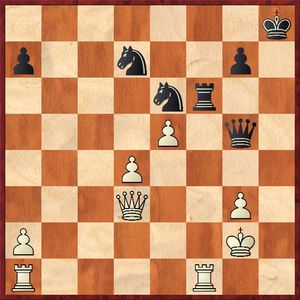
Oparin admitted at a press conference to not seeing anything decisive after 29...Nf4+! 30.Rxf4 Rxf4 31.Rh1+ Kg8. Indeed, after 32.Qb3+ (32.Qc4+ Rf7) 32...Rf7 33.Rf1 (33.e6 Qd2+ 34.Kh3 Qh6+) 33...Qd2+ 34.Kh1 Nxe5! 35.dxe5 Qh6+ 36.Kg1 Qb6+! 37.Qxb6 axb6 – Black has fears neither of a pawn nor of a rook ending, with an easy draw in any of them.
29... Rh6? 30.Rac1 g6 31.Rc8+ Kg7 32.Qf3 Qe7 33.d5, and the white pawns ripped through the black cavalry.
If feels happy for Oparin on the one hand, and otherwise for Kobalia. Mikhail was the only player giving a simul during a rest day, then senior coach of the Russian youth team also published an article in favor of rights of children participating at the European Championship. Where is justice here?
Going into round eight, Oparin is pursued by Daniil Dubov, Ernesto Inarkiev, Evgeny Tomashevsky, Dmitry Andreikin and Dmitry Jakovenko. So, it’s everybody’s tournament at the moment.
In the women's tournament, Polina Shuvalova upset Anastasia Protopopova, while Alisa Galliamova and Valentina Gunina made draws. Despite the result, Gunina’s game was another display of fireworks.
Alexandra Kosteniuk continued carpet bombing of the French defense, Alexander Goryachkina being her victim this time around.
Kosteniuk – Goryachkina
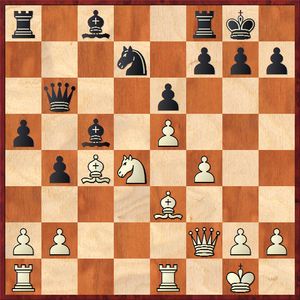
White is ready for the offensive, but what Black is supposed to do? Perhaps, it was worth giving consideration to 17...a4, to try force the trade of light-squared bishops. This long-range piece played a vital role in further onslaught launched by the ex-world champion.
17…Ba6 18.Bb3 Rfd8 19.Rac1 Rac8 20.f5! Kh8
All lines are nice, some of them even giving White a choice: 20...Nxe5 21.fxe6 Ng4 22.exf7+ Kh8 23.Rxc5 Nxf2 24.Ne6, winning.
21.fxe6 Nxe5 22.Rxc5!
Not only does an exchange sacrifice takes the white battery to the firing line, it also eliminates defender of the f8-square.
22…Qxc5 23.Nf5 Qb5 24.e7 Nd3
24...Re8 25.Bd4 f6 26.Bxe5 fxe5 27.Nd6 is not difficult to see, but the text does not lure Kosteniuk into taking the rook, supplying our website’s Position of the Day with another diagram.

25.Nh6! Nxf2 (25...gxh6 26.Qf6+ with a checkmate) 26.Nxf7+, and Black resigned.
Anastasia Bodnaruk encounter vs Elena Tomilova was an interesting one - first White sacrificed a pawn, then Black gave back two in return!
Bodnaruk – Tomilova
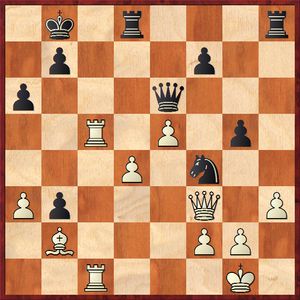
White is objectively better on the diagram position, but in time trouble Bodnaruk was,probably apprehensive of Qe6-f5. It does not feel like Kh2, while 33.Re1 is a challenge from the psychological point of view. However, the rook move would have helped Bodnaruk strengthen along the third rank, because the main thing is to pull out a splinter from b3. On the other hand, a self-suggestive
33.Rc7? was met by 33...Qd5! 34.Qxd5
An attempt to pepper up by ditching a piece with 34.Qg4 Nd3 35.R1c3 Nxb2 36.R7c5 runs into a nice refutation from Black: 36…Na4! 37.Rxd5 Nxc3 38.Rxd8+ Rxd8 39.Qxg5 Rc8 40.Qd2 Na4, and the birth of a new black queen is inevitable. White gives back an exchange.
34...Rxd5 35.R7c4 Ne2+ 36.Kf1 Nxc1 37.Rxc1 Rc8 38.Rxc8+ Kxc8 39.Ke2 Rd7 40.Kd3 Rc7, and after time control Tomilova launched her queenside pawns forward, which finally queened. Interestingly, the black pawn was on b3 from move eleven, and its hour eventually struck.
Meanwhile, the tournament lead in the women's section before the rest day was taken by Olga Girya and Alina Kashlinskaya. Olga gained an edge over Natalija Pogonina, who parted with a pawn in search of counterplay; however, Girya figured out the complications.
Girya – Pogonina

25... Bxf3 26.gxf3 Qb4
More stubborn is 26...Ra8 27.Ra2 Qe7 28.a6 Ra7, but keeping a passive rook stance in front of a far-advanced passer is not something that one might look forward to. Natalija opted for an active defense.
27.a6 Rb5 28.Qd7 Ra8 29.Qc6 Ra7 30.Rd8+ Kh7 31.Qc8 Rb6
Black piled up on the a-pawn, but bad things come in threes - while the heavy pieces are busy eliminating the passer, there is no one to protect the king.
32.Rh8+ Kg6 33.Kh1 Rbxa6 34.e4 Re6 35.Qg8
An effective end to the battle was after 35.Rg1+ Kf6 36.Qd8+ Ree7 (36...Rae7 37.Rxh6+ gxh6 38.Qh8#) 37.Rxg7 Qe1+ (37...Kxg7 38.Qf8+ Kf6 39.Qxh6#) 38.Kg2 Ra1 39.Rxh6+ Kxg7 40.Qh8#.

35...Kf6
Black could have set the last trap via 35...Qd2 36.Rg1+ Kh5 37.Qxg7 Rg6 38.Rxg6 fxg6, and 39.Qxa7? Qc1+ 40.Kg2 Qg5+ gives a perpet.
On the other hand, there is a simple 39.Qxe5+ Qg5 40.Qg3!, emerging up two pawns.
36.Rg1 g6 37.Rh7 Ree7 38.Rxh6 Reb7 39.Rgxg6+ Ke7
39...fxg6 40.Rxg6+ Ke7 41.Re6+ Kd7 42.Qe8+ Kc7 43.Rc6# is a forced checkmate. The rest is easy.
40.Re6+ fxe6 41.Rxe6+ Kd7 42.Qe8+ Black resigns.
Gritsayeva – Kashlinskaya
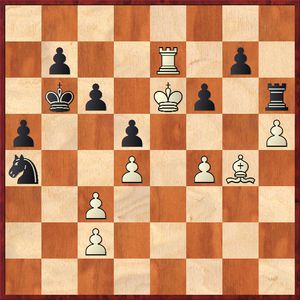
Standing worse in the endgame, Gritsayeva rushed her king into the opponent’s camp. This said, a naive 38...Nxc3? 39.Kf7 Rh8 40.Kxg7 Ra8 41.Re1 a4 42.h6 a3 43.h7 a2 44.Ra1 Kb5 45.Be6! hands over a victory to White! However, Alina is on the alert!
38...f5+! 39.Kxf5 Nxc3 40.Rxg7 a4 41.Ke5?
White errs making a time control move, whereas after 41.Bf3! Rh8 (or 41...Nb5 42.Ke5 Rh8 43.Rg1 Re8+ 44.Kf6 Nxd4 45.Bg4 Nxc2 46.Kf7 Ra8 47.h6) 42.Rg1 a3 43.Ra1 a2 44.Kf6 it is not yet clear who is going to queen first!
41...a3 42.Bc8 Rxh5+ 43.f5 a2 44.Rxb7+ Ka5 45.Ra7+ Kb5 46.Bd7
Gritsayeva grabs the b7-pawn and eyeballs her c6-fellow, but Kashlinskaya uncorks a petite combination, as Capablanca termed it.
46…Rh7 47.Ke6
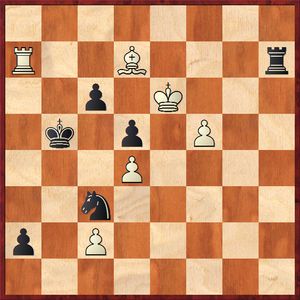
47...Rxd7! 48.Rxa2
After 48.Kxd7 Na4 the black pawn queens.
48...Rh7 49.Rb2+ Kc4 50.Rb6 Kxd4 51.Rxc6 Ne4 52.c3+
52.f6 Nxf6!
52...Nxc3 53.f6 Ne4 54.Rc1 Nc5+ 55.Kf5
55.Kd6 is simplest met by 55…Rd7+ 56.Kc6 Rf7 57.Rxc5 Rxf6+ 58.Kb5 Rf8, and there is no stopping the black pawn.
55...Rh5+ 56.Kg6 Rh2 57.f7 (or 57.Rf1 Nd7) 57...Rf2 58.Re1 Nd7 59.Kg7 Kc5 60.Re6 d4 61.Ra6 d3, winning.
After the rest day the tournament leaders made draws. It is for the second time that Girya (this time, white pieces were with Goryachkina) shows excellent preparation in the Fischer line 1.e4 c6 2.d4 d5 3.ed cd 4.Bd3 Kc6 5.c3, which enjoys a revival. The database shows experienced grandmasters, classics of Caro-Kann suffering bitter defeats in recent years. And here is Girya with proper improvements, posting her knights here and there to give Black a fine position. Positional understanding is not something that the athlete from Langepas lacks. When talking about Olga Girya’s games, “women's chess" is not something I can bring myself to say at all.
Alina Kashlinskaya could have increased her lead had she managed to upset Alisa Galliamova. However, in a position with substantial edge - a pawn and initiative with opposite-colored bishops - the leader rushed to trade the queens. Then Alisa Galliamova proved that her rook blunder is an accident, whereas she, in fact, is very good at endgames with opposite-colored bishops. Kashlinskaya did everything she could, but it was a draw nonetheless.
Valentina Gunina also used all her chances against Polina Shuvalova, who blundered an inch away from the draw.
Gunina – Shuvalova

73...Nh2
73...Rxf2 74.Bxg4 Ke4, intending Kе3 and the knight retreat was an option.
74.Be6 Ra6?
This is beyond repair already! After 74...Ra3 Black were eliminating Black’s last pawns via Nf1:g3 to have decent drawing chances in a rook vs rook and bishop endgame, demonstrating knowledge of the old Cochrane or second-rank defensive methods.
75.Rf5+ Kxe6
Alas, in a rook ending White is up two pawns already - 75...Kd4 76.Rf4+ Ke5 77.Bxg4 Nxg4 78.Rxg4 Kf5 79.Rf4+ Kg5 80.Rf8 Ra7+ 81.Rf7 Ra6 82.f4+ Kg4 83.f5, but an exchange sacrifice is of no help either.
76.Rf6+ Ke5 77.Rxa6 Ke4 78.Rh6 Nf1 79.Rf6, and Gunina ended up clinching into the share of first.
Having defeated Anastasiya Protopopova, the ex-world champion Alexandra Kosteniuk has joined the pursuit of leaders. The young chess player from Saratov is given a hard time by elite players, but I do hope that she will bang the door at the end. After all, fresh in memory are examples when home stretches saw will power shown by Ekaterina Ubiennykh and a first-timer Oksana Gritsayeva, whose tournaments started badly otherwise.
Tomilova – Gritsayeva
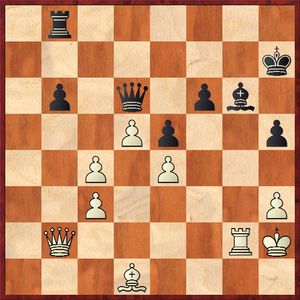
The athlete from Crimea got a dubious position out of the opening, but was defending very tenaciously and resourcefully, and now it is no longer clear whether White is able to convert his extra doubled pawn. However, Elena Tomilova found a way to win, which involved... a blunder!
43.Qf2! Bxe4
43...Rg8 fails to 44.Qh4 Kh6 45.Bxh5.
44.Rg1!
At the press conference Tomilova admitted to having 44.Bc2? Bxc2 45.Qxc2+ in her advanced calculations, and only at this moment realizing that Black has 45…e4+ at her disposal. Fortunately for White, however, the rook retreat wins.
44...Bg6
44...Rg8 45.Qh4! Rxg1 46.Qxe4+ f5 47.Qxf5+ Qg6 48.Qxg6+ Rxg6 49.Bc2 gives White a winning pawn ending.
45.Qg3 Rg8 46.Bc2!
The most precise move. Sergei Rublevsky showed that after transposing into a pawn ending the simplest path to success is 46...f5 47.Bxf5 Qf6 48.Bxg6+ Rxg6 49.Qxg6+ Qxg6 50.Rxg6 Kxg6 51.h4 Kf5 52.Kg3 e4 53.Kf2 Kf6 54.Ke3 Ke5 55.c5 bxc5 56.c4 Kf5 57.d6 Ke6 58.Kxe4 Kxd6 59.Kf5. Gritsayeva saw these lines, but had no decent alternatives available to her already.
46…Qc5 47.Bxg6+ Kh6 48.d6 Rg7 49.d7 Rg8 50.Qh4 e4 51.Qf4+ Black resigns.
Natalija Pogonina vs Anastasia Bodnaruk was a mutual amnesty in a severe time trouble.
Pogonina - Bodnaruk
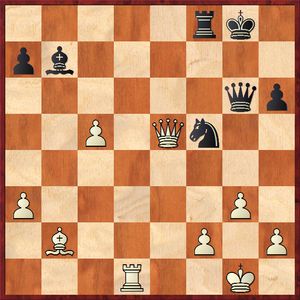
White has three pawns for a piece, but both central diagonals are exposed. Black should have taken care of safety: 34...Re8 35.Qc3 Bc6, with a potential resource of Nh4.
34...Qc6? 35.f3 Kh7
35...Qxf3 36.Qh8+ Kf7 37.Qf6+ Kg8 38.Qg6+ results in a checkmate, but now White could have disturbed the knight by a winning 36.g4! - and Black loses a piece.
36.Rd6?? Qb5??
A return blunder in lieu of a winning 36...Qxf3 37.Rd7+ (37.c6 Bxc6) 37...Kg6 38.Rd6+ Kh5 – the black king is safely out, and who is going to help his white counterpart?
37.Rd8?
37.g4 was a winner again, but Pogonina delivers a perpet to put an end to this drama on hanging flags.
37...Rxd8 38.Qxf5+ Kg8 39.Qg6+ Kf8 40.Qf6+ Ke8 41.Qe6+ Kf8 42.Qf6+ Draw.
Going into round eight, in the lead are Olga Girya, Alina Kashlinskaya and Valentina Gunina with 4.5 points. They are pursued by Alisa Galliamova, Alexandra Kosteniuk, Aleksandra Goryachkina and Natalija Pogonina, with 4 points apiece. It is good news that Alexander Tkachev has come to the tournament. He immediately started by discussing all nuances of a potential tie-break with the panel of arbiters. I wonder, if this is going to be the case. We will know it soon enough!















